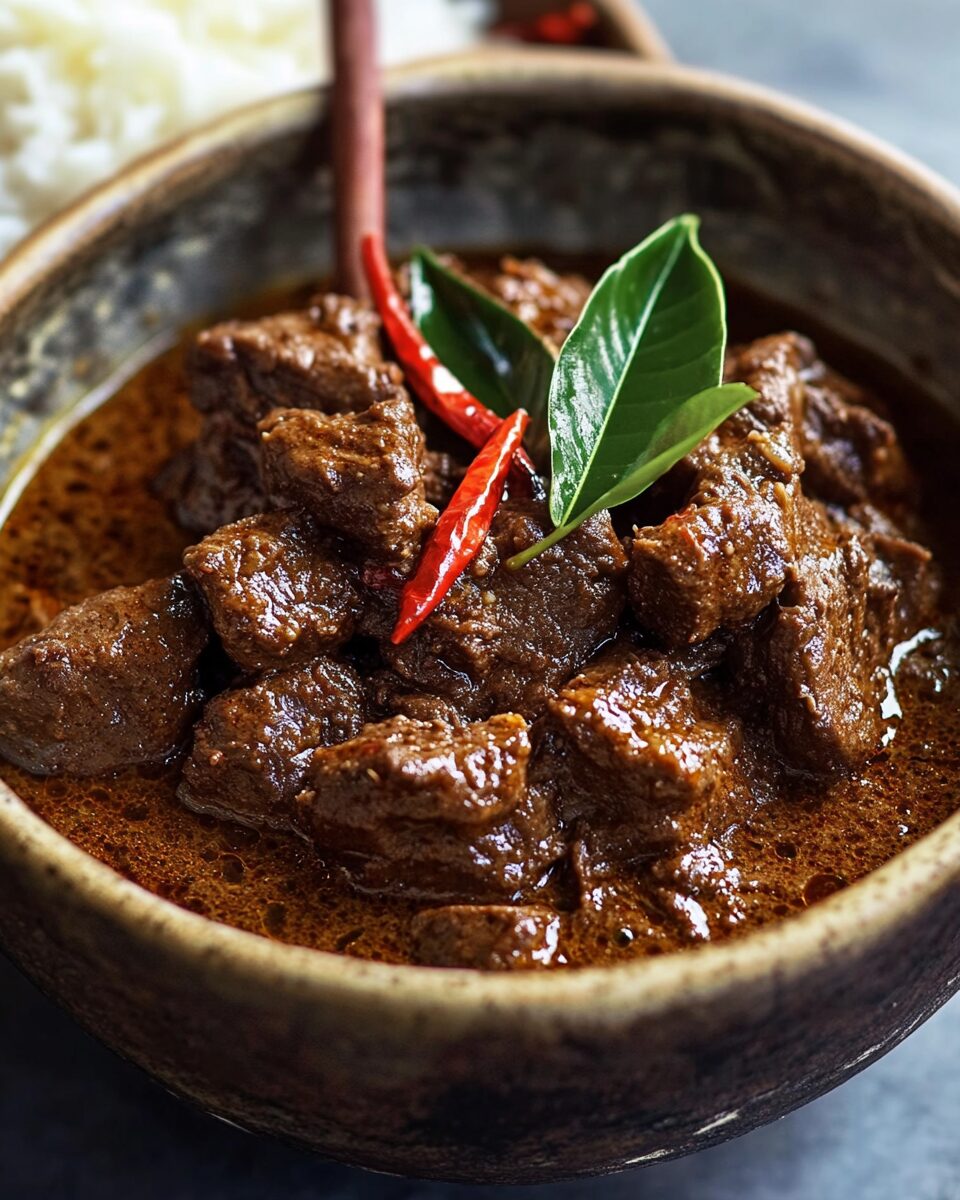Beef Rendang is a traditional Indonesian dish known for its rich, aromatic flavors. Slow-cooked to perfection, this tender beef stew is infused with a complex blend of spices, coconut milk, and herbs. The slow simmering process allows the flavors to develop, resulting in a dish that’s both savory and slightly sweet. Often served during special occasions and festivals, Beef Rendang is a culinary delight that pairs wonderfully with steamed rice.
FULL RECIPE
Ingredients
- Beef
- Coconut milk
- Lemongrass
- Galangal
- Garlic
- Shallots
- Ginger
- Turmeric
- Kaffir lime leaves
- Bay leaves
- Red chilies
- Tamarind paste
- Coconut oil
- Salt
- Sugar
Directions
- Cut the beef into chunks and set aside.
- Blend garlic, shallots, ginger, turmeric, and red chilies into a smooth paste.
- Heat coconut oil in a large pot over medium heat and sauté the spice paste until fragrant.
- Add lemongrass, galangal, kaffir lime leaves, and bay leaves. Stir well.
- Add the beef chunks and cook until browned.
- Pour in the coconut milk and tamarind paste. Stir to combine.
- Reduce the heat and simmer uncovered for 2-3 hours, stirring occasionally to prevent sticking.
- Allow the sauce to thicken and the beef to become tender. Adjust seasoning with salt and sugar to taste.
- Continue cooking until the oil separates from the sauce, enhancing the flavor.
Nutrition Facts
- Calories: 500-600 kcal
- Protein: 40g
- Fat: 35g
- Carbohydrates: 20g
- Fiber: 3g
- Sodium: 700mg
Historical Background
The origins of Beef Rendang trace back to the Minangkabau people, who created the dish as a way to preserve meat for long journeys. Its preparation method, which involves slow cooking with coconut milk and spices until dry, ensured the meat remained edible without refrigeration. Over time, the dish became a staple of celebratory feasts and rituals, symbolizing wealth and generosity.
Influence on Global Cuisine
With the spread of Indonesian culture, Beef Rendang has gained recognition worldwide. It has become a popular dish in Southeast Asian restaurants and frequently appears on lists of the world’s most delicious foods. Culinary enthusiasts have adapted the recipe using local ingredients while maintaining its characteristic taste, further promoting the cultural significance of the dish.
Sustainability Considerations
When preparing Beef Rendang, choosing sustainably sourced beef and coconut milk can contribute to environmentally friendly practices. Supporting local farmers and purchasing organic ingredients ensures ethical sourcing and reduces the carbon footprint. Additionally, incorporating plant-based versions using mushrooms or tofu can make the dish accessible to vegetarian or vegan diets.
Festive Celebrations
Beef Rendang often takes center stage during Indonesian festivals such as Eid al-Fitr and family gatherings. It is customary to prepare large batches, allowing families and communities to enjoy the meal together. The labor-intensive cooking process also fosters a sense of unity and pride in traditional cooking methods passed down through generations.
Popularity in Media
Beef Rendang has frequently been featured in cooking shows, travel documentaries, and food blogs. Its complex cooking technique and rich cultural background make it a favorite subject for culinary storytellers. As it continues to captivate global audiences, the dish remains a celebrated ambassador of Indonesian cuisine.
Cultural Significance
Beef Rendang holds a special place in Indonesian culture, particularly among the Minangkabau people of West Sumatra. It is traditionally served during ceremonial events and family gatherings, symbolizing prosperity and togetherness. As a dish that takes time and patience to prepare, it embodies the values of dedication and hospitality. Variations of Rendang can also be found in neighboring countries such as Malaysia and Singapore, often adapted to regional tastes while preserving its authentic essence.
Flavor Profile and Cooking Techniques
The complex flavor of Beef Rendang is achieved through the careful layering of aromatic spices, herbs, and creamy coconut milk. The use of galangal, lemongrass, and kaffir lime leaves imparts a citrusy, earthy undertone, while red chilies add a moderate level of heat. The coconut milk not only enriches the sauce but also caramelizes as it reduces, contributing to the deep brown color and nutty flavor that characterizes the dish. Unlike conventional stews, Beef Rendang is cooked until the sauce fully thickens and coats the meat, resulting in a dry, intensely flavored finish.
Regional Variations
While the traditional Minangkabau Rendang remains iconic, various regions have introduced their own interpretations. In Padang, the dish is often spicier with a thicker sauce, while in neighboring regions, it may have a slightly wetter consistency. Malaysian Rendang tends to be sweeter, incorporating additional palm sugar. Meanwhile, some variations include additional ingredients like toasted coconut or tamarind to enhance the tanginess. Each version maintains the dish’s core essence while reflecting the unique culinary heritage of the region.
Pairing Suggestions
Beef Rendang is best enjoyed with steamed white rice, which complements the rich and bold flavors. It also pairs well with nasi lemak, a Malaysian coconut rice dish, or ketupat, a compressed rice cake traditionally served during festive occasions. For a complete meal, consider adding fresh cucumber slices, pickled vegetables, or a side of sambal for an extra kick. Additionally, pairing Rendang with a light cucumber salad or a cooling yogurt sauce can balance the spice and provide a refreshing contrast.
Storage and Reheating Tips
One of the unique qualities of Beef Rendang is its ability to develop even more depth of flavor over time. Properly stored in an airtight container, it can last up to five days in the refrigerator. When reheating, it is best to do so over low heat, adding a splash of water to loosen the sauce if necessary. For longer storage, Rendang can be frozen for up to three months. Its robust flavors make it an excellent choice for meal prepping or serving as a make-ahead dish for gatherings.
Health Benefits
Although Beef Rendang is a rich and indulgent dish, it also offers several nutritional benefits. The spices used in the recipe, such as turmeric and ginger, are known for their anti-inflammatory properties. Coconut milk provides healthy fats that support heart health, while lean cuts of beef offer high-quality protein. To make the dish healthier, consider reducing the amount of coconut milk or using a leaner cut of meat.
Conclusion
Beef Rendang is a true representation of Indonesian culinary heritage, bringing together tradition, flavor, and artistry in every bite. Its meticulous preparation and vibrant flavor profile make it a memorable dish for both special occasions and family meals. Whether enjoyed in its classic form or with regional adaptations, Beef Rendang stands as a testament to the rich cultural tapestry of Southeast Asia. Serve it alongside your favorite accompaniments and savor the delightful blend of spices that has captivated food lovers around the world.






